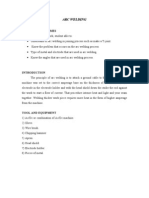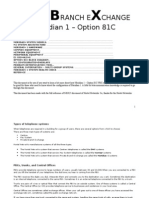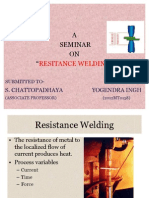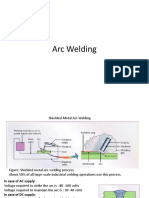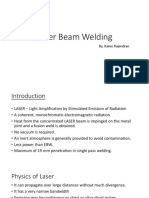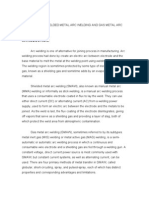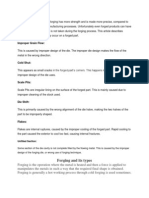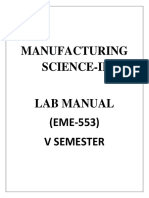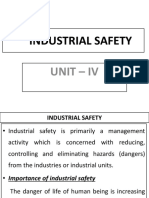Spot Welding Process Lab
Uploaded by
junaid gujratiSpot Welding Process Lab
Uploaded by
junaid gujratiCarbon Resistor experiment
Resistance spot welding
Background
Resistance spot welding is a process in which faying surfaces are joined in one or more spots
by resistance to the flow of electric current through workpieces that are held together under
force by electrodes. The contacting surfaces in the region of current concentration are heated
by a short-time pulse of low-voltage, high-amperage current to form a fused nugget of weld
metal. When the flow of current ceases, the electrode force is maintained while the weld
metal rapidly cools and solidifies. The electrodes are retracted after each weld, which usually
is completed in a fraction of a second.
The size and shape of the individually formed welds are limited primarily by the size and
contour of the electrode faces. The weld nugget forms at the faying surfaces, as shown in
Figure 1, but does not extend completely to the outer surfaces. In section, the nugget in a
properly formed spot weld is round or oval in shape; in plan view, it has the same shape as
the electrode face (which is usually round) and approximately the same size. Spacing
between adjacent spot welds or rows of spot welds must be enough to prevent shunting or to
limit it to an acceptable amount.
Current flow Upper electrode
Workpieces
Lower electrode Nugget
Applications
Spot Resistance Welding is widely used in joining sheet steel of thickness up to about .125 “
and can be used for many material including combinations of materials, refer to Appendix A
for material weldability chart.. Many assemblies of two or more sheet-metal stampings that
do not require gas-tight or liquid-tight joints can be more economically joined by high-speed
resistance spot welding than by mechanical methods. Containers such as receptacles are spot
welded. The attachment of braces, brackets, pads or clips to formed sheet-metal parts such as
cases, covers, bases or trays is another common application of spot welding. One of the most
important applications of resistance spot welding is in automotive industry-the car frame
body is constructed by spot welding of individual stamping parts, with manual portable
welding guns, semi-automatic machines or fully automatic robots.
Advantages
Major advantages of resistance spot welding are high speed and suitability for automation
and inclusion in high-production assembly lines with other fabricating operations. With
computer PLC control of current, timing and electrode forces, sound spot welds can be
produced consistently at high production rates and low unit labor costs by unskilled
operators.
IEFR Faisalabad Mechanical Engineering 1
Carbon Resistor experiment
Principle of Operation
The operation of spot welding involves a coordinated application of current of the proper
magnitude for the correct length of time. This current must pass through a closed circuit. Its
continuity is assured by forces applied to the electrodes, which are shaped to provide the
necessary density of current and pressure. The entire sequence of operations is required to
develop sufficient heat to raise a confined volume of metal, under pressure, to temperature
must be such that fusion or incipient fusion is obtained, but not so high that molten metal will
be forced from the weld zone. The rates of the rise and fall of temperature must be
sufficiently rapid to obtain commercial welding speeds, but neither rate may be permitted to
be so rapid that either inconsistent or brittle welds will be produced. The rates of rise and fall
of temperature and the time of maintenance at temperature are determined by the
characteristics of the metals being welded and by the capacity of available equipment.
The heat required for any resistance welding process is produced by the resistance offered to
the passage of an electric current through the workpieces, in exactly the same manner as in
any other electrical heating device. Since the electrical resistance of metals is low, high
welding currents are required to develop the necessary welding heat. Typically the currents
are in the range of 1000’s of Amps, while the voltage is at the level of a few Volts only.
The rate of heat generation depends upon the flow of current, in amperes, through the
resistance offered by the materials. Other electrical factors, such as voltage, frequency and
power factor, enter into consideration only with respect to their uniformity. They affect only
the value of the current.
According to Ohm’s law,
𝐸
𝐼=
𝑅
where I is the current, E is voltage drop across the electrodes and R is the resistance through
the material in ohms. R is the summation of the contact resistances and the resistance of the
work to be welded. Therefore, for a given value of R, the magnitude of I is determined by E.
Current to the primary of the transformer is controlled which, in turn, determines the current
delivered to a weld of a given resistance. The total heat in watt-seconds generated in the work
being welded and in the welding electrodes is expressed by the formula:
H I 2 RT
Or
H IET
T is time in seconds.
Welding Cycle
The welding cycle is divided into four to five time segments: squeeze, preheat, weld,postheat,
hold and off. These are shown in Figure 2. The time is expressed in cycles, where 1 second
equals 60 cycles (60 Hz frequency of the AC voltage used).Squeeze time is the time between
the initial application of the electrode pressure on the work,
IEFR Faisalabad Mechanical Engineering 2
Carbon Resistor experiment
and the first application of current in making spot weld. It provides time for the solenoid
actuated head cylinder valve to operate and for the welding head to bring the upper electrode
in contact with the workpiece and develop full electrode force. For this lab this time is 60
cycles. Preheat is a low current applied in the time interval before the full welding current is
applied. Preheat is an optional segment. l It reduces thermal gradients in the metal. The
preheat step is not used in this lab.
Weld time is the interval during which the welding current flows through the circuit. Postheat
time is the interval during which current is on at a low level. It is used chiefly for grain
refinement (tempering) on hardenable carbon and alloy steels. It is optional. For this lab it is
10 cycles at 20% power.
Hold time is the interval during which, after the welding current is off, the electrode force is
held on the workpiece until the metal of the spot weld has solidified. Off time is the interval
from the end of the hold time until the beginning of the squeeze time for the next cycle. It is
the time needed to retract the electrodes, remove or reposition workpiece.
All of the segments are usually expressed in cycles, meaning the number of cycles in a 60-
cycle system, where one cycle is 1/60 second.
RULES FOR MAKING GOOD WELDS
1. Too short squeeze time can result in metal expulsion, burned electrodes, bad welds,
marked work, and damaged ignitron tubes or SCRs.
2. Too long weld time will shorten the life of the electrodes, cause excessive indentation
and cause internal cracks which can result in weld failures.
3. You cannot judge weld quality by looking at the finished weld. If non-destructive testing
is used, test strips of the same material and combination must be used.
IEFR Faisalabad Mechanical Engineering 3
Carbon Resistor experiment
4. Too short weld time will result in low weld strength, assuming all other factors are
normal.
5. Too short hold time can result in surface expulsion, electrodes sticking, internal cracks in
weld nugget and sometimes even cracks in parent metal. Follow the tables for minimum
time.
6. Weld pressure too low can result in expulsion of metal, electrode damage (sticking),
short electrode life, internal cracks in weld nugget and sometimes excessive indentation.
7. Weld pressure too high can result in low or variable weld strength, excessive weld
current
requirements, mushrooming of electrodes, and excessive indentation.
8. With all other settings correct, adjust weld current to meet weld quality standards.
9. Electrode contact face too small will result in too small a spot, excessive electrode
mushrooming, and excessive indentation. Too large an electrode contact area will result
in too large a weld (assuming current is set accordingly) and internal cracks.
10. Electrodes misaligned or mismatched will result in expulsion and displaced weld nugget
and accelerated electrode wear.
11. Insufficient cooling will result in mushroomed and short life electrodes, cracks on the
surface and excessive indentation in some cases. It is very important that the water flow in
through the water quill and back out the outside of the quill. Also, the water quill must be
bottomed gently against the inside of the electrode cavity every time an electrode is replaced.
4-
IEFR Faisalabad Mechanical Engineering 4
You might also like
- Basics Configuration of PBX - Nortel Meridain 81c100% (4)Basics Configuration of PBX - Nortel Meridain 81c26 pages
- "Spot Welding": Mindanao University of Science and Technology C.M. Recto Avenue, Lapasan, Cagayan de Oro CityNo ratings yet"Spot Welding": Mindanao University of Science and Technology C.M. Recto Avenue, Lapasan, Cagayan de Oro City10 pages
- Robot Welding Technology (Robotic Welding)No ratings yetRobot Welding Technology (Robotic Welding)16 pages
- Gen - Importance of Welding in L & T PDFNo ratings yetGen - Importance of Welding in L & T PDF30 pages
- 1 - MMAW Process - PPT (Compatibility Mode)100% (1)1 - MMAW Process - PPT (Compatibility Mode)44 pages
- Joining Process MIG Welding: Faculty of Mechanical EngineeringNo ratings yetJoining Process MIG Welding: Faculty of Mechanical Engineering4 pages
- The Effect of Current On SMAW Welding To Tensile Strength and Micro Structure of Low Carbon SteelNo ratings yetThe Effect of Current On SMAW Welding To Tensile Strength and Micro Structure of Low Carbon Steel5 pages
- Resistance Welding: Indian Institute of Welding - ANB Refresher Course - Module 10No ratings yetResistance Welding: Indian Institute of Welding - ANB Refresher Course - Module 1040 pages
- Laboratory Exercise-I Spot Welding Objective: AdvantagesNo ratings yetLaboratory Exercise-I Spot Welding Objective: Advantages4 pages
- Weldability: Introduction and Factor Affecting It100% (2)Weldability: Introduction and Factor Affecting It15 pages
- Milling: Prepared By: Dinbandhu Singh 1No ratings yetMilling: Prepared By: Dinbandhu Singh 123 pages
- Unit 2-Chapter 6 - Heat Treatment of Metals100% (1)Unit 2-Chapter 6 - Heat Treatment of Metals55 pages
- Spot Welding, Types, Applications, Advantages and DisadvantagesNo ratings yetSpot Welding, Types, Applications, Advantages and Disadvantages6 pages
- GMAT and GMAT Waiver Fact Sheet Updated 3-10-16 Read OnlyNo ratings yetGMAT and GMAT Waiver Fact Sheet Updated 3-10-16 Read Only3 pages
- 9MA0 01 9MA0 02 A Level Pure Mathematics Practice Set 13No ratings yet9MA0 01 9MA0 02 A Level Pure Mathematics Practice Set 135 pages
- Lower Level Upper Level: Men's and Home Men's and HomeNo ratings yetLower Level Upper Level: Men's and Home Men's and Home1 page
- Mrmia Vendor Model Documentation StandardNo ratings yetMrmia Vendor Model Documentation Standard4 pages
- Copyreading and Headline Writing - Samantha F. Batalla100% (1)Copyreading and Headline Writing - Samantha F. Batalla56 pages
- Information and Database Quality Information and Database QualityNo ratings yetInformation and Database Quality Information and Database Quality239 pages
- Bethke, Bruce & Day, Vox - Rebel Moon (1416501908) PDFNo ratings yetBethke, Bruce & Day, Vox - Rebel Moon (1416501908) PDF147 pages
- Killer Bean From Animation To Cult PhenomenonNo ratings yetKiller Bean From Animation To Cult Phenomenon3 pages
- Instant Access to Emotions as Original Existences: A Theory of Emotion, Motivation and the Self 1st ed. Edition Demian Whiting ebook Full ChaptersNo ratings yetInstant Access to Emotions as Original Existences: A Theory of Emotion, Motivation and the Self 1st ed. Edition Demian Whiting ebook Full Chapters41 pages
- Write The Verbs in Brackets in The Correct FormNo ratings yetWrite The Verbs in Brackets in The Correct Form1 page
- Folding Flat Silhouettes and Wrapping Polyhedral Packages: New Results in Computational OrigamiNo ratings yetFolding Flat Silhouettes and Wrapping Polyhedral Packages: New Results in Computational Origami10 pages
- "Spot Welding": Mindanao University of Science and Technology C.M. Recto Avenue, Lapasan, Cagayan de Oro City"Spot Welding": Mindanao University of Science and Technology C.M. Recto Avenue, Lapasan, Cagayan de Oro City
- Joining Process MIG Welding: Faculty of Mechanical EngineeringJoining Process MIG Welding: Faculty of Mechanical Engineering
- The Effect of Current On SMAW Welding To Tensile Strength and Micro Structure of Low Carbon SteelThe Effect of Current On SMAW Welding To Tensile Strength and Micro Structure of Low Carbon Steel
- Resistance Welding: Indian Institute of Welding - ANB Refresher Course - Module 10Resistance Welding: Indian Institute of Welding - ANB Refresher Course - Module 10
- Laboratory Exercise-I Spot Welding Objective: AdvantagesLaboratory Exercise-I Spot Welding Objective: Advantages
- Spot Welding, Types, Applications, Advantages and DisadvantagesSpot Welding, Types, Applications, Advantages and Disadvantages
- GMAT and GMAT Waiver Fact Sheet Updated 3-10-16 Read OnlyGMAT and GMAT Waiver Fact Sheet Updated 3-10-16 Read Only
- 9MA0 01 9MA0 02 A Level Pure Mathematics Practice Set 139MA0 01 9MA0 02 A Level Pure Mathematics Practice Set 13
- Lower Level Upper Level: Men's and Home Men's and HomeLower Level Upper Level: Men's and Home Men's and Home
- Copyreading and Headline Writing - Samantha F. BatallaCopyreading and Headline Writing - Samantha F. Batalla
- Information and Database Quality Information and Database QualityInformation and Database Quality Information and Database Quality
- Bethke, Bruce & Day, Vox - Rebel Moon (1416501908) PDFBethke, Bruce & Day, Vox - Rebel Moon (1416501908) PDF
- Instant Access to Emotions as Original Existences: A Theory of Emotion, Motivation and the Self 1st ed. Edition Demian Whiting ebook Full ChaptersInstant Access to Emotions as Original Existences: A Theory of Emotion, Motivation and the Self 1st ed. Edition Demian Whiting ebook Full Chapters
- Folding Flat Silhouettes and Wrapping Polyhedral Packages: New Results in Computational OrigamiFolding Flat Silhouettes and Wrapping Polyhedral Packages: New Results in Computational Origami


